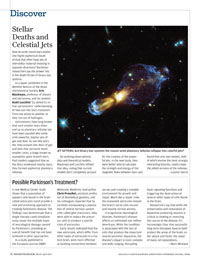Discover
 JET SETTERS: Are binary star systems the reason some planetary nebulae collapse into colorful jets? (Photo: NASA/ESA & Valentin Bujarrabal (Observatorio Astronomico Nacional, Spain))
JET SETTERS: Are binary star systems the reason some planetary nebulae collapse into colorful jets? (Photo: NASA/ESA & Valentin Bujarrabal (Observatorio Astronomico Nacional, Spain))How do some round stars evolve into highly aspherical clouds of dust that often have jets of interstellar material shooting in opposite directions? Rochester researchers say the answer lies in the death throes of binary star systems.
In a paper published in the Monthly Notices of the Royal Astronomical Society, Eric Blackman, professor of physics and astronomy, and his student Scott Lucchini ’13, aimed to refine astronomers’ understanding of how sun-like stars transition from one phase to another as they run out of hydrogen.
Astronomers have long known that such smaller stars often end up as planetary nebulae but have been puzzled why some emit powerful, bipolar jets of gas and dust. As sun-like stars die, they expand into discs of gas and dust that surround much smaller cores, a stage known as asymptotic giant branch stars. Past models suggested that as the discs enveloped nearby stars, they formed aspherical planetary nebulae. By
studying observational data and theoretical models, Blackman and Lucchini refined that idea, noting that current models don’t completely account for the creation of the powerful jets. In the new study, they were better able to calculate the strength and energy of the magnetic flows between stars and found that only two models, both of which involve the most strongly interacting binaries, could create the jetted versions of the nebulae.
—Leonor Sierra
Possible Parkinson’s Treatment?
A new Medical Center study shows that a population of support cells found in the brain called astrocytes could provide a new and promising approach to treating Parkinson’s disease. The findings may demonstrate that a single therapy could simultaneously repair the multiple types of neurological damage caused by Parkinson’s, providing an overall benefit that has not been achieved in other approaches.
In a study published in the European journal EMBO Molecular Medicine, lead author Chris Proschel, assistant professor of biomedical genetics, and his colleagues reported that by carefully manipulating a population of central nervous system cells called glial precursors, they were able to induce the precursor cells to produce a specific class of astrocytes.
Early results indicated that the new astrocytes, which differ from other types of astrocytes in a mature brain, were more effective at building connections between nerves and creating a suitable environment for growth and repair. Much like a repair crew, the implanted astrocytes helped the brain’s nerve cells recover and resume normal activity.
A progressive neurological disorder, Parkinson’s disease affects an estimated one million Americans. While the condition is associated with the loss of cells that produce the important neurotransmitter dopamine, the disease’s impact is more complex and wide-ranging, disrupting basic signaling functions and triggering the destruction of several other types of cells found in the brain.
Researchers say that while the preservation and restoration of dopamine-producing neurons is critical to slowing or reversing the course of the disease, it’s increasingly clear that successful long-term therapies have to both protect the areas of the brain under attack and foster the repair of many cell populations.
—Mark Michaud
How to Measure Stroke Care
Are measures of mortality providing an accurate picture of care for stroke victims? According to a study by Rochester researchers, that may not be the case.
Published in the journal Stroke, the study found that wide variation in the use of do-not-resuscitate (DNR) orders can significantly skew a hospital’s quality “ranking” based on mortality. In an examination of data from 355 hospitals in California from 2005 to 2011, the study looked at 252,368 stroke cases and found that some hospitals used DNRs in an average of 2.2 percent of stroke cases, while others used them an average of 23.2 percent of the time. As expected, the hospitals with a greater percentage of DNRs generally had higher mortality rates.
“With mortality increasingly being used as a marker for the quality of care provided to stroke patients, it is essential that we understand the impact of decisions made by physicians and families to limit or withhold care,” says Adam Kelly, a neurologist with the School of Medicine and Dentistry and chief of neurology at Highland Hospital.
Physicians have questioned whether mortality is an appropriate measure of stroke care because DNRs are often put in place to limit some life-extending interventions for patients who have had a severe stroke. But, the authors point out, mortality statistics do not distinguish between an individual who has died because of poor or unsafe care versus someone who died because a conscious decision was made to withhold invasive or heroic measures.
—Mark Michaud
Longer Life? Be ‘In Control’
The less education you have, the more your attitude counts when it comes to staying alive and well. That’s the finding of a new study conducted by personality researchers from Rochester and Brandeis University. Lead author Nicholas Turiano, a postdoctoral fellow in psychiatry, and his team found that adults without college degrees live longer if they feel like they’re in control of their lives. Those who reported feeling little control had mortality rates that were three times higher than those who felt in control.
Published by the American Psychological Association’s Health Psychology journal, the study followed 6,135 people, ages 25 to 75, for 14 years. Respondents were part of an ongoing, national questionnaire called the National Survey of Midlife in the United States that collects assessments of perceived ability to exert influence over life circumstances. Turiano cautions that more research is needed to find out why or how people develop a strong sense of control, or when the development occurs, but researchers suspect innate and external factors contribute to a sense of control.
—Julie Philipp
 TURF BATTLES: A lack of legislative focus often undercuts metropolitan areas, new research indicates. (Photo: iStockphoto)
TURF BATTLES: A lack of legislative focus often undercuts metropolitan areas, new research indicates. (Photo: iStockphoto)Infighting May Undermine Large Cities in State Legislatures
Urban legislators have long lamented that they don’t get their fair share of bills passed in state governments, often blaming rural and suburban interests for blocking their efforts. A new study confirms one of those suspicions but surprisingly refutes the other.
In an analysis of 1,736 bills in 13 states over 120 years, authors Gerald Gamm, associate professor of political science at Rochester, and Thad Kousser of the University of California, San Diego, found that big-city legislation does get passed at dramatically lower rates than bills affecting less metropolitan areas, but the two conclude that infighting within city delegations often undermines legislative success for urban areas.
Reported in the American Political Science Review, the analysis was based on a study of so-called district bills, legislation that affects only a single locality or county. The researchers are the first to document the fate of big-city legislation and to test with hard data the reasons metropolitan areas are often stymied in state politics.
“The data show that because of their large numbers, delegations from major cities like Chicago or New York are more likely to be at odds on legislation than smaller delegations, muddling cues for others in the chamber,” says Gamm. “After all, if the delegates from a city can’t coalesce behind a bill, why should legislators from other parts of the state vote for the law?”
—Susan Hagen

